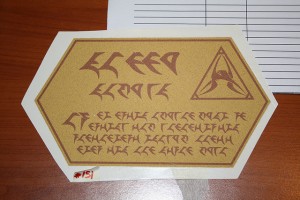 An undergrad recently asked me about Lojban.
An undergrad recently asked me about Lojban.
Those in computer science and related fields have probably heard of Lojban (a constructed language, formerly known as Loglan). And most of us have heard of Esperanto (a “universal” language), and other “constructed” languages such as R’lyehian and, of course, Klingon.
Are there a lot of artificial languages? (They’re also referred to as “planned,” “invented,” “made-up,” and probably a few other terms as well.) Yes, indeed there are.
I started my exploration with A Dictionary of Made-up Languages (2011). The introduction tells us that there are more than 100 “made-up” languages; for the scope of this book, the author focused only on those that are written and/or spoken, leaving out sign languages and computer languages.
I loved Appendix A: Works, Language Creators, and the Languages Associated with Them (p. 273), which lists many favorite languages of us fantasy and science fiction fans, including
- Lapine (in Watership Down by Richard Adams)
- Dothraki (in A Dance with Dragons by George R. R. Martin)
- Parseltongue (in some of the Harry Potter books and movies by J.K. Rowling)
- Stark (in the Ender series by Orson Scott Card)
- Elvish, Dwarvish, and other languages in Tolkien’s world
- Newsspeak (in Nineteen Eighty-four by George Orwell)
- Anglic (in the Uplift Universe, as described in Startide Rising and the others in the series by David Brin)
How *should* we refer to these languages? Our JHU catalog shows that there’s been a lot of interest in languages that “everyone” can speak, and somewhat less interest in the kind of languages that we’re discussing here:
- 525 “language, universal”
- 6 “imaginary languages”
- 23 “languages, artificial”

However, other catalogs such as the Library of Congress and WorldCat show quite a few more books about artificial and imaginary languages.
Google’s N-Gram Viewer shows that “invented,” “planned,” and “made-up” were never popular, and “constructed” had tiny blips in the mid-1850s, 1930, and the mid-1940s. “Artificial language” has always been around and was at its highest use in the mid-1960s.
As shown, the much more popular term has always been — at least since 1800 — “universal language.” Unlike languages spoken by fictional groups, or entities who don’t usually speak (at least that we know of), like the animals in Animal Farm, a universal language is spoken by everyone (whomever that may be). The universal language could also be used for communicating in a group who all have different primary languages (as Esperanto was used in Philip Jose Farmer’s vast and imaginative Riverworld series [use Borrow Direct for these]).
On your next study break, wander down to D Level — on the BLUE shelves, in the P120.I53 section, browse through Encyclopedia of Fictional and Fantastic Languages or Lunatic Lovers of Language: Imaginary Languages and Their Inventors.
Try it yourself, or see what other “conlangers” are doing.
